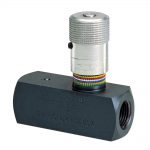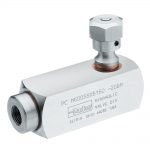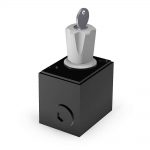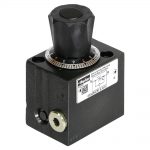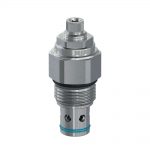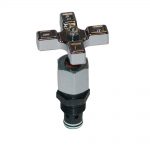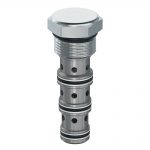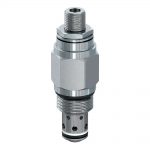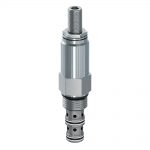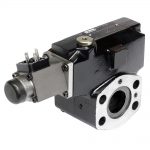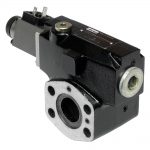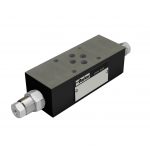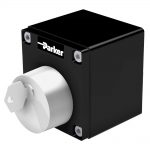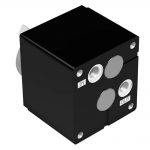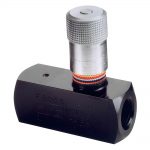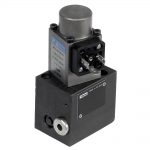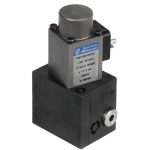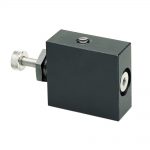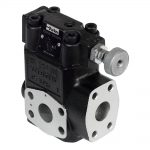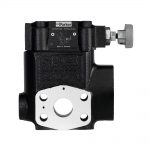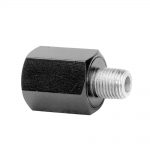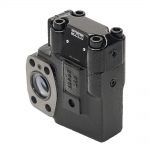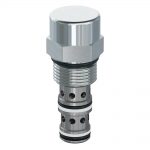HYDRAULIC FLOW CONTROL VALVES
HYDRAULIC FLOW CONTROL VALVES
Parker’s hydraulic flow control valves are known throughout the industry for their performance and reliability. Parker valves are used in a range of applications such as conveyors, food processing machines and material handling equipment. We offer a diverse range of products that ensure velocity by guaranteeing consistent flow regardless of load. Flow control valves come in a variety of materials including stainless steel, brass and carbon steel.
HYDRAULIC FLOW CONTROL VALVES INCLUDE
[/fancy_heading][fancy_heading h1=”0″]
[/fancy_heading]
Parker’s F Series valve is an economical, general purpose flow control valve that permits free flow in one direction and metered flow in the reverse direction in air, water and oil applications.
Parker’s F Series valves have either fine or standard metering needles for flow control and a fully guided poppet for free flow in reverse direction. Our superior, fully guided poppet design eliminates wobble and erratic travel that can commonly occur with less durable ball check type construction. The standard soft seat poppet on these check valves provide near zero leakage and come standard in sizes up to 1/2”.
Markets:
• Factory Automation
• Machine Tools
• Marine
• Material Handling
• Mining
• Miscellaneous Industrial
• Miscellaneous Manufacturing
• Molding
• Oil &Gas
• Power Generation
• Vehicle Assembly Facilities
Features/Benefits:
• Port options include ISO 6149, NPT, BSPP, BSPT and SAE
• Material offerings are brass, steel and stainless steel
• Tamperproof option available
• The exclusive “Colorflow” color-band provide an accurate visual indication of setting
• Set screw locks the valve on a desired setting
Applications:
• Suitable for general hydraulic applications
Parker’s PC*M series valves regulates flow at a selected rate within 5% regardless of fluctuations in inlet and outlet flow. This valve can be used with a variety of fluids including water and oil applications.
Parker’s PC*M Pressure Compensated Flow Control valve comes with an adjustable needle or with a factory set fixed flow rate. The adjustable setting can be secured with a standard set screw or a thumbscrew option that does not require additional tools.
Markets:
• Factory Automation
• Machine Tools
• Marine
• Material Handling
• Mining
• Miscellaneous Industrial
• Miscellaneous Manufacturing
• Molding
• Oil &Gas
• Power Generation
• Vehicle Assembly Facilities
Features/Benefits:
• Port options include NPT and SAE
• Available with reverse flow check
• Port sizes available in 6 sizes from ¼” to 1 ¼”
• The exclusive “Colorflow” color-band provide an accurate visual indication of setting
• Set screw locks the valve on a desired setting
Applications:
• Suitable for general hydraulic applications
2-way flow control valves series GFG provide pressure compensated flow for a precise movement control. The valve design largely compensates temperature variations.
Parker’s 2-way flow control valves series GFG ensure a constant flow rate independent of pressure and temperature fluctuations. The GFG is optionally equipped with a built-in check valve for the return flow.
Markets:
• Industrial
• Machine tools
Features/Benefits:
• Pressure compensated flow – movements are precisely executed
• Wide range of different flow rates – enables fine adjustment
• Short delivery time – no warehousing necessary
• External port (P) to block flow from A to B
• Optional reverse flow check valve
• Turn knob with cylinder lock (option S)
Applications:
• Suitable for general hydraulic applications
• Machine tool
Design:
The 2-way flow control valves are used with a triangular flow restrictor and a subsequent pressure compensator. The setting of the flow rate can be locked by a cylinder lock in the adjusting knob against unauthorized adjustment (option S).
Function:
The fluid enters through port A through the flow restrictor. Downstream of the flow restrictor the pressure compensator is located. The control edges are provided by four radial bores in the poppet, which are fully open to port B in the neutral position. Optionally the flow from A to B can be blocked by external pilot pressure applied to port P (option X). This can be used to avoid unintended initial movements of actuators. The flow adjustment is done via the hand knob with an adjusting angle knob of 270°.
Parker offers standard needle valves and needle valves with a reverse free-flow check. Parker’s needle valves are non-compensated adjustable orifices capable of flows up to 225 lpm (60 gpm) and pressures as high as 420 bar (6000 psi).
Parker’s family of needle valves feature a highly contamination tolerant design that allows for fine metering with manual adjustment to create and orifice and control flow. These valves can operate with hydraulic system flows as high as 225 lpm and pressures up to 420 bar with the option of an integrate reverse free-flow check valve. Parker’s needle valves or needle-check valves are ideal for cylinder or motor control and/or bleed-off applications within a broad range of markets, such as the agriculture, construction, material handling, industrial, oil & gas, and several more.
Markets:
• Agriculture
• Construction Equipment
• Material Handling Equipment
• Miscellaneous Industrial
• Miscellaneous Mobile
• Oil & Gas
Features/Benefits:
• High flow capacity from a small cavity
• Manual shutoff with extremely low leakage
• Fine adjustment control/sensitivity
• Very tolerant to contamination
• Tamperproof options available
• Free-flow reverse check available
• All external parts zinc plated
Applications:
• Accumulator bleed-off
• Motor speed control
• Cylinder speed control
Additional Technical Insight:
Needle valves offer economical solutions for applications that require basic adjustable control of hydraulic flow. The effective orifice size inside the valve is varied with screw or knob adjustments and the valve can be made tamper resistant with the addition of an optional cap. Shutoff can be achieved when the valve is adjusted completely closed. Once the adjustment is set, the valve acts as a fixed orifice. Like all fixed orifices, any changes in pressure will cause changes in flow. If constant flow is required regardless of system or load pressure, please consider Parker’s pressure compensated flow controls. Parker’s J02A2, NVH081, NVH101, and J06A2 cartridges are standard 2-port needle valves with fine adjustment options available. The orifice will meter in both directions, but flow from port 2 to 1 is preferred. If unrestricted reverse flow is required, an additional check valve will need to be used with these needle valve versions. Parker also offers J02B2, FV101, and FV102 needle valves with internal reverse free flow checks in order to reduce manifold size and component quantities.
Parker’s MVI series is a cartridge-type metering valve that meters flow in both directions.
Parker’s MVI cartridge-type needle valves are designed for installation in a precision-machined cavity made in the manifold of the machine and can be used in air, water & oil applications. These valves provide precise metering control and full shutoff of flow. An o-ring and backup ring installed on the cartridge fully isolate the inlet and outlet ports of the machined cavity from each other.
Markets:
• Factory Automation
• Machine Tools
• Marine
• Material Handling
• Mining
• Miscellaneous Industrial
• Miscellaneous Manufacturing
• Molding
• Oil &Gas
• Power Generation
• Vehicle Assembly Facilities
Features/Benefits:
• High efficiency o-ring stem seal eliminates packing
• Fine and micro-fine needles available for extremely fine control
• The exclusive “Colorflow” color-band provide an accurate visual indication of setting
Applications:
• Suitable for general hydraulic applications
Parker offers four different flow divider/combiner valves to cover a wide range of flows up to 320 lpm (85 gpm) and pressures as high as 420 bar (6,000 psi). Standard and custom ratios are available, along with optimized flow range options.
Parker’s family of flow divider/combiner valves feature interlocking spools for pressure compensation in both directions while either dividing or combining the flow. These valves can operate with hydraulic system flows as high as 320 lpm and pressures up to 420 bar with a selection of dividing/combining ratios available. Parker’s divider/combiner valves are ideal for cylinder or motor synchronization applications within a broad range of markets, such as the construction, material handling, industrial markets, oil & gas, and many more.
Markets:
• Construction Equipment
• Material Handling Equipment
• Miscellaneous Industrial
• Miscellaneous Manufacturing
• Miscellaneous Mobile
• Oil & Gas
Features/Benefits:
• Interlocking spools for equal control dividing or combining
• Pressure compensated control in both directions
• Hardened, precision ground parts for durability
• Ratios of 50-50, 60-40, and 66-33 available
• All external parts zinc plated
Applications:
• Cylinder synchronization
• Motor synchronization
• Flow partitioning
• Transmission differentials
Additional Technical Insight:
Each of Parker’s four flow divider/combiner versions can be used as a divider or combiner depending on the direction of flow. Two inter-locking spools allow for pressure compensated flow division and combination to be proportioned based on the selected ratio and flow range. When port 3 is supplied flow it is divided by a fixed ratio to work ports 2 and 4. For example, if a 50:50 ratio is selected, half of the flow will exit port 2 and the other half will exit port 4. If the actuators have the same area or displacement they will operate at the same speed. If different actuator speeds are required, alternative ratios can be selected to supply different flows to each port. Ratios other than 50:50 can allow speed synchronization of two actuators that have different areas or displacements. The flow to each actuator port is proportional to the inlet flow based on the flow division ratio. When used as a combiner, flow applied to ports 2 and 4 is combined and the total flow exits port 3. The flow from the combiner inlet ports is pressure compensated and the flow ratio determines how much flow is allowed from each port. Just like the divider mode, the combiner mode allows for actuator speed variation or synchronization. Typical flow accuracy is +/- 10% between ports 2 and 4. When trying to synchronize 2 cylinders or motors, cross-port relief valves or balancing orifices can be used to help maintain tighter synchronization. Parker’s FDC101, L04A3, L06A3 and L1A300 flow divider/combiners operate in the same manner with each having a different maximum flow and multiple standard ratios and flow ranges.
Parker offers a wide range of pressure compensated flow controls for applications that demand constant flow with varying loads and pressures; handling pressures as high as 420 bar (6000 psi) and flows to 56 lpm (15 gpm) in a single common cavity.
Parker’s family of pressure compensated flow control valves feature a proven design that allows for a reliable and repeatable flow compensation curve throughout a wide pressure range. These valves can operate with hydraulic system flows as high as 56 lpm and pressures up to 420 bar with the option of an integrated adjustable or tuneable reverse free-flow check valve. Parker’s pressure compensated flow control valves are ideal for cylinder or motor control and/or bleed-off applications within a broad range of markets, such as the agriculture, construction, material handling, industrial, and oil & gas markets.
Markets:
• Agriculture
• Construction Equipment
• Material Handling Equipment
• Miscellaneous Industrial
• Miscellaneous Mobile
• Oil & Gas
Features/Benefits:
• Minimal flow change with pressure variation
• Reverse flow function
• Hardened working parts for maximum durability
• Tamperproof options available
• All external parts zinc plated
Applications:
• Accumulator bleed-off
• Motor speed control
• Cylinder speed control
• Power units
Additional Technical Insight:
Parker offers a wide range of spool type restrictive pressure compensated flow controls to allow for speed control of motors, cylinders, and rotary actuators. Pressure compensation allows the flow devices to maintain a constant flow even with varying loads and inlet pressures. Tunable and fully adjustable versions are available with screw or knob adjusters that can be made tamper resistant with the addition of an optional cap. FR101 is an adjustable pressure compensated flow regulator which compensates for varying loads and pressures in one direction but in the other direction flow is metered across a fixed orifice but not compensated. In order to allow pressure compensated flow control in one direction and full free flow in the opposite direction, Parker offers an internal check valve in the adjustable FC101 cartridge. Because both versions are tunable and not fully adjustable, the valve will need to be specified with the appropriate flow range for the application. Changes in flow rates are achieved by mechanically varying the spring force acting on a spool that has a fixed orifice and metering compensator. J02E2, J04C2, and J04E2 are fully adjustable pressure compensated flow regulators. In the opposite flow direction, those valves only meter through a fixed orifice and do not compensate. In order to achieve fully adjustable pressure compensated flow control while allowing reverse full flow, the FA101 includes an internal check valve to bypass the compensator and metering orifice.
Pressure compensated priority flow control valves maintain constant flow regardless of changes to inlet pressure for flows up to 90 lpm (24 gpm) and pressures up to 420 bar (6000 psi); excess flow is diverted once the priority flow requirement is met.
Parker’s family of pressure compensated priority flow control valves feature a proven design that allows for a reliable and repeatable flow compensation curve throughout a wide pressure range while ensuring priority flow is met. These valves can operate with hydraulic system flows as high as 90 lpm and pressures up to 420 bar with a selection of adjustment and tamper-proof options. Parker’s pressure compensated priority flow control valves are ideal for steering, brake, or actuator control applications within a broad range of markets, such as the agriculture, construction, material handling, industrial, and oil & gas markets.
Markets:
• Agriculture
• Construction Equipment
• Material Handling Equipment
• Miscellaneous Industrial
• Miscellaneous Mobile
• Oil & Gas
Features/Benefits:
• Fine adjustments
• Reverse flow function
• Hardened working parts for maximum durability
• Tamperproof options available
• All external parts zinc plated
Applications:
• Steering applications
• Actuator speed control
• Meter-in circuits
Additional Technical Insight:
Priority style pressure compensator flow control valves maintain constant priority flow to one leg of a circuit regardless of any changes in load or inlet pressure. Once the priority flow is satisfied, any excess flow may be used in other parts of the circuit. The valve consists of a control orifice housed within a spring biased compensator spool. This orifice may be fixed or adjustable. The priority port is normally open while the bypass port is normally closed. As flow enters the inlet port of the cartridge, it passes through the control orifice. A pressure differential is created across the compensator spool. If the inlet flow exceeds the setting of the valve, the force produced by this pressure differential exceeds the spring force and shifts the compensator spool; opening up the bypass port, and bypassing the excess flow. If the load pressure at the bypass port is greater than the load pressure at the priority port, the compensator spool will further shift restricting the priority flow to that of the valve setting. However, caution should be taken if the priority gets blocked so that no flow can pass through the control orifice, the compensator spool will shift, blocking the bypass port and allowing inlet pressure to go to full system relief pressure. It is common to place an external relief valve downstream of the priority flow port to prevent a no flow condition.
Parker’s PM*CS series valves are designed to regulate flow at a selected rate.
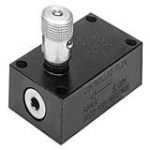
Pcms Series
Parker’s PM*CS series valves are used for pressure compensated regulation of the flow. As a consequence of pressure changes, the set value can vary by ± 5 % within the tolerance range. Changes in viscosity and in temperature have the same effect and are to be observed.
Markets:
• Factory Automation
• Machine Tools
• Marine
• Material Handling
• Mining
• Miscellaneous Industrial
• Miscellaneous Manufacturing
• Molding
• Oil &Gas
• Power Generation
• Vehicle Assembly Facilities
Features/Benefits:
• Available with reverse flow check
• Port sizes available in 5 sizes from ¼” to 1”
• The exclusive “Colorflow” color-band provide an accurate visual indication of setting
• Set screw locks the valve on a desired setting
Applications:
• Suitable for general hydraulic applications
Proportional throttle valves series F5C with SAE61 flange allow to adjust the flow in proportion to the input signal.
Proportional throttle valves series F5C with SAE flange are designed to adjust the flow in proportion to the input signal without the need for a manifold block or piping between the valves. They are part of the Parker valve range with SAE flanges which is unique in its variety. The combination of the F5C with pressure compensators R5A or R5P serves as a flow control valve – providing load compensated flow.
The F5C is offered with two types of response time:
• Standard 350 ms at 1 l/min pilot flow
• Code A 250 ms at 2 l/min pilot flow
Markets:
• Industrial
Features/Benefits:
• Proven, robust design – ensures reliable operation
• Various function options – useable for numerous applications
• Good price-performance ratio – fast return of investment
• Short delivery time – no warehousing necessary
• Spool type proportional throttle valve
• SAE61 flange – enables compact design
• Maximum flow 380 l/min – optimum efficiency in relation to valve size
• 3 sizes, SAE 3/4“, 1“, 1 1/4“
• Load compensated flow in combination with R5A and R5P
Applications:
• Suitable for general hydraulic applications
The proven counterbalance valve series ZNS in size NG06 (CETOP 03) and NG10 (CETOP 05) enables a reliable operation by controlling the actuator movement at overrunning loads.
Parker counterbalance valves series ZNS in sandwich design control the actuator movement at overrunning loads via a leak-free poppet valve. Thereby they enable a reliable operation and a linear lowering speed of the cylinder.
The return flow from the actuator is piloted and controlled by the inlet flow to the actuator, ensuring a cavitation-free lowering of the load. The counter balance valve operates as a pressure relief valve. The setting pressure is lowered by the pressure in the inlet line.
Markets:
• Industrial
• Machine tools
Features/Benefits:
• Compact, proven design that represents our long-term experience in hydraulics
• Controlled movement loads – prevents cavitation
• Load holding via leak-free poppet valve – ensures reliable operation
• Short delivery time – no warehousing necessary
• Available in two sizes:
– ZNS*01 – NG06 (CETOP 03)
– ZNS*02 – NG10 (CETOP 05)
• Secondary relief protection for the actuator
Applications:
• Suitable for general hydraulic applications
• Machine tools
Please note:
To ensure safe load holding the setting pressure should be approximately 30 % higher than the max. load pressure.
2-way flow control valves series 2F1C in size NG 10 and NG16 provide a pressure and viscosity compensated flow. Additionally they avoid unintended initial actuator motion.
Parker’s proven 2-way flow control valves series 2F1C in size NG10 and NG16 feature a constant, pressure, temperature and viscosity compensated flow from port A to port B. Due to their sophisticated design, they enable a linear cylinder movement by suppressing starting jumps. The counter direction is blocked (standard) or can be open via an integral reverse flow check valve (optional).
Markets:
• Industrial
Features/Benefits:
• Excellent fine adjustment – precise pressure control
• Adjustable response time – for optimum adaption to the application
• Flexible, versatile mounting in any orientation – makes installation easy
• Subplate mounting according to ISO 6263 – for quick integration
• Short delivery time -no warehousing necessary
• Closed in neutral position
• Optional reverse flow check valve
• 2 sizes, NG10 (3/8“), NG16 (3/4“)
Applications:
Suitable for general hydraulic applications
Function:
The compensator spool is located in front of the metering spool. The metering spool is closed in the neutral position to avoid unintended initial actuator motion. The oil flow to open the metering spool has to pass a needle valve. The needle valve can be adjusted from the front panel to set the response time of the 2F1C. The metering spool is adjusted by the main control knob.
The key lock has three positions:
Lock: Adjustment is locked
Adjust: Full adjustment is permitted
Trim: Fine adjustment of ±5 % is possible
Parker’s FS series flow control valve offers superior construction and high versatility due to its variety of materials, sizes and port styles. It can be used in both the mobile and industrial markets.
Parker’s FS series flow control valve offers superior construction and high versatility due to its variety of materials, sizes and port styles. It can be used in both the mobile and industrial markets.
The FS series flow control valve comes in 5 sizes ranging from 5 to 40 GPM.
Markets:
• Factory Automation
• Machine Tools
• Marine
• Material Handling
• Mining
• Miscellaneous Industrial
• Miscellaneous Manufacturing
• Molding
• Oil &Gas
• Power Generation
• Vehicle Assembly Facilities
Features/Benefits:
• Pressures up to 3,000 PSI
• 5 mounting sizes with flows up to 40 GPM
• Needle and poppet are stainless steel
• Set screw or optional finger screw locks needle flow position
Applications:
• Suitable for general hydraulic applications
Parker’s PC*K series is a pressure compensated flow control valve that regulates flow at a selected rate within 5% regardless of fluctuations in inlet and outlet flow. This valve can be used with a variety of fluids including water and oil applications
Parker’s PC*K Pressure Compensated Flow Control Valves comes with an adjustable needle or with a factory set fixed flow rate. The adjustable setting can be secured with a standard set screw or a thumbscrew option that does not require additional tools.
Markets:
• Factory Automation
• Machine Tools
• Marine
• Material Handling
• Mining
• Miscellaneous Industrial
• Miscellaneous Manufacturing
• Molding
• Oil &Gas
• Power Generation
• Vehicle Assembly Facilities
Features/Benefits:
• Port options include NPT and SAE
• Available with reverse flow check
• Port sizes available in 4 sizes from ¼” to ¾””
• Set screw locks the valve on a desired setting
Applications:
• Suitable for general hydraulic applications
As an extremely precise and sensitive proportional flow control valve in size NG06, the DUR*L06 is predestined for the use in machine tools in which small flow must be exactly controlled. It is equipped with a built-in check valve for the return flow.
Parker’s proven proportional flow control valves of the series DUR*L06 are used to generate pressure-compensated flow from A to B e. g. for a precise adjustment of tools. The valves are equipped with a built-in check valve for the return flow. For meter-in and meter-out control of an actuator, a rectifier plate can be used.
Markets:
• Industrial
• Machine tools
Features/Benefits:
• Extremely sensitive control of low volume, load-independent flows – movements are precisely executed
• Wide range of different flow rates – enables fine adjustment
• Low hysteresis – allows a sensitive response
• High reproducibility – for reliable operation
• Short delivery time – no warehousing necessary
• Bypass check valve
• Mounting pattern to ISO 6263
• 4 flow rates: 1.6, 6.3, 12.0, 18.0 liters/minute
Applications:
• Suitable for general hydraulic applications
• Predestined for the use in machine tools
Function
When solenoid current is applied, the metering spool opens against the reset spring and the flow is regulated by the pressure compensating spool to port B.
With the aid of the pressure compensating spool, the pressure drop is held constant on the metering window. Thus pressure load changes are compensated, and the oil flow remains constant.
In combination with the digital electronic module PCD00A-400 the valve parameters can be saved changed and duplicated.
Parker’s GT series valves isolate gages from damage and inaccurate readings caused by line pressure surges and hydraulic hammer.
Parker’s GT Series valve has a push-to-read knob that delivers instant pressure to the gauge, yet isolates the gauge from the fluid line until the knob is pressed. When the knob is released, a spring-loaded spool closes instantly and drains all fluid from the gauge back into the reservoir.
Markets:
• Factory Automation
• Machine Tools
• Marine
• Material Handling
• Mining
• Miscellaneous Industrial
• Miscellaneous Manufacturing
• Molding
• Oil &Gas
• Power Generation
• Vehicle Assembly Facilities
Features/Benefits:
• Has a hardened steel spool
• Partial Snubbing action protects the gauge from surge
• Optional panel mount
Applications:
• Suitable for general hydraulic applications
Direct operated 3-way pressure compensators series R5P with SAE flange can be combined with fixed or adjustable flow resistors (throttles) to provide a load compensated flow.
Parker’s direct operated 3-way pressure compensators series R5P can be combined with any type of fixed or adjustable flow resistor (throttle) to provide a load compensated flow even under high flow conditions. They are part of the Parker valve range with SAE flanges which is unique in its variety. The SAE flanges allow to mount the valves directly on the outlet flanges of pumps to achieve a very compact design.
The combination with the proportional throttle valve F5C serves as a compact 3-way flow control unit in SAE flange design. The R5P is typically used as meter-in compensator in front of the flow resistor.
The R5P is additionally equipped with a pressure relief pilot that controls the compensator cartridge and operates as system pressure relief valve. The R5P*P2 provides a proportional relief function.
Markets:
• Industrial
Features/Benefits:
• Modular system for proportional pressure controls in SAE flange design, together with the 2-way pressure compensator R5A and the proportional throttle valve F5C
• Perfect for flow controls with fixed displacement pumps – can be directly mounted on the outlet flange
• Proven, robust design – ensures reliable operation
• Various function options – useable for numerous applications
• SAE61 flange – enables compact design
• Maximum pressure of 350 bars and flow capacity ranging from 90 l/min to 600 l/min – high performance
• Good price-performance ratio – fast return of investment
• Short delivery time – no warehousing necessary
• Seated type 3-way pressure compensator
• 8.4 bar control pressure
• Pressure relief function (optionally proportional)
• With optional vent function
• 3 sizes, SAE 3/4“, 1“, 1 1/4“
Applications:
• Suitable for general hydraulic applications
Parker’s GF series valves isolate gages from damage and inaccurate readings caused by line pressure surges and hydraulic hammer.
Parker’s GF Series valve uses a capillary orifice to smooth out line pulsations and surges without the use of any moving parts. Featuring one piece construction and requires no adjustment or maintenance.
Markets:
• Factory Automation
• Machine Tools
• Marine
• Material Handling
• Mining
• Miscellaneous Industrial
• Miscellaneous Manufacturing
• Molding
• Oil &Gas
• Power Generation
• Vehicle Assembly Facilities
Features/Benefits:
• One piece construction
• Requires no adjustment or maintenance
Applications:
• Suitable for general hydraulic applications
Parker’s priority pressure compensators provide constant flow regardless pressure changes via a fixed or adjustable orifice with priority to one outlet port. These valves can handle flows up to 95 lpm (25 gpm) and pressures up to 380 bar (5500 psi).
Parker’s family of priority pressure compensator valves feature a robust and contamination tolerant design that ensures consistent flow regardless of up or down stream pressures while providing priority to one outlet port. These valves can operate with hydraulic system flows as high as 95 lpm and pressures up to 380 bar with a variety of differential pressure setting and adjustment options. Parker’s pressure compensator valves are ideal for constant and consistent flow applications that contain functions that requires priority such as conveyors or saws within mobile, industrial, or manufacturing markets.
Markets:
• Miscellaneous Industrial
• Miscellaneous Manufacturing
• Miscellaneous Mobile
Features/Benefits:
• Contamination tolerant
• Stable and quiet response
• Hardened working parts for maximum durability
• All external parts zinc plated
Applications:
• Conveyors
• Steering applications
• Saws
• Constant and consistent flow applications
Additional Technical Insight:
Flow through the external orifice (fixed or variable) enters the supply port and produces a pressure drop across the compensator spool. When the inlet pressure exceeds the initial setting of the valve, the force produced by the pressure differential across the spool exceeds the spring force and shifts the compensator spool to throttle, or restrict, the flow, thus maintaining constant flow through the priority port. The excess flow is bypassed out to the system to be used by another function, or back to the system reservoir. Flow out the regulated port must be maintained for bypass flow to continue. For this reason, common practice dictates a pressure control (relief) be installed in the priority line.
Direct operated 2-way pressure compensators series R5A with SAE flange can be combined with fixed or adjustable flow resistors (throttles) to provide a load compensated flow.
Parker’s direct operated 2-way pressure compensators series R5A can be combined with any type of fixed or adjustable flow resistor (throttle) to provide a load compensated flow even under high flow conditions. They are part of the Parker valve range with SAE flanges which is unique in its variety. The SAE flanges allow to mount the valves directly on the outlet flanges of pumps to achieve a very compact design.
The combination with the proportional throttle valve F5C serves as a compact 2-way flow control unit in SAE flange design. The R5A is typically used as meter-out compensator behind the flow resistor.
Markets:
• Industrial
Features/Benefits:
• Proven, robust design – ensures reliable operation
• SAE61 flange – enables compact design
• Maximum pressure of 350 bars and flow capacity ranging from 90 l/min to 600 l/min – high performance
• Good price-performance ratio – fast return of investment
• Short delivery time – no warehousing necessary
• Seated type 2-way pressure compensator
• 8.4 bar control pressure
• 3 sizes, SAE 3/4“, 1“, 1 1/4“
• Load compensated flow in combination with F5C
Applications:
• Suitable for general hydraulic applications
Parker’s pressure compensator valves provide constant flow regardless of upstream or downstream pressure changes via a fixed or adjustable orifice. These valves can handle flows up to 150 lpm (40 gpm) and pressures up to 245 bar (3500 psi).
Parker’s family of pressure compensator valves feature a robust and contamination tolerant design that ensures consistent flow regardless of up or down stream pressures. These valves can operate with hydraulic system flows as high as 150 lpm and pressures up to 245 bar with a variety of differential pressure setting options. Parker’s pressure compensator valves are ideal for constant and consistent flow applications such as conveyors or saws within mobile, industrial, or manufacturing markets.
Markets:
• Miscellaneous Industrial
• Miscellaneous Manufacturing
• Miscellaneous Mobile
Features/Benefits:
• Stable and quiet response
• Contamination tolerant
• Hardened working parts for maximum durability
• All external parts zinc plated
Applications:
• Conveyors
• Saws
• Constant and consistent flow applications
Additional Technical Insight:
Inlet flow (upstream of the orifice or flow control valve) is split with one portion going to the compensator port inlet, the other portion passes through the orifice, or flow control valve, to the supply port. As pressure drop across the orifice reaches the selected compensator pressure drop, the higher pressure (pre-orifice) starts to shift the compensator spool into a throttling position. The valve works to maintain a constant pressure drop across the orifice. Using this type of valve allows greater flexibility in design and flows as these valves can flow as much as 40 gallons per minute. Compensator valves are used in circuits where a constant flow is desired regardless of upstream or downstream loads. As the pressure downstream of the compensator increases, the valve is forced open to maintain the constant pressure drop across the fixed, or adjustable, orifice. Conversely, if the pressure increases upstream of the orifice, the compensator valve will be forced closed to maintain the constant pressure drop across the orifice.
- IN-LINE FLOW CONTROL VALVE–F SERIES
- IN-LINE PRESSURE COMPENSATED VALVE-PC*M SERIES
- 2-WAY FLOW CONTROL VALVE-SERIES GFG2
- NEEDLE FLOW CONTROL VALVES
- PRECISION NEEDLE VALVE–MVI SERIES
- FLOW DIVIDER/COMBINER VALVES
- PRESSURE COMPENSATED FLOW CONTROL VALVES
- PRESSURE COMPENSATED PRIORITY FLOW CONTROL VALVES
- FLOW CONTROL VALVE,SUBPLATE MOUNTED-PC*MS SERIES
- PROPORTIONAL THROTTLE VALVE - SERIES F5C
- COUNTERBALANCE VALVE - SERIES ZNS
- 2-WAY VARIABLE FLOW CONTROL VALVE-SERIES 2F1C
- FLOW CONTROL, SUBPLATE MOUNTED VALVE–FS SERIES
- IN-LINE PRESSURE COMPENSATED VALVE-PC*K SERIES
- PROPORTIONAL FLOW CONTROL VALVE 2 WAY-SERIES DUR*L06
- IN-LINE PUSH-TO-READ GAUGE ISOLATOR VALVE-GT SERIES
- PRESSURE COMPENSATOR, SAE FLANGE-SERIES R5P
- IN-LINE GAUGE ISOLATOR VALVE–GF SERIES
- PRIORITY PRESSURE COMPENSATORS
- PRESSURE COMPENSATOR, SAE FLANGE-SERIES R5A
- PRESSURE COMPENSATORS/CONTROL ELEMENTS

